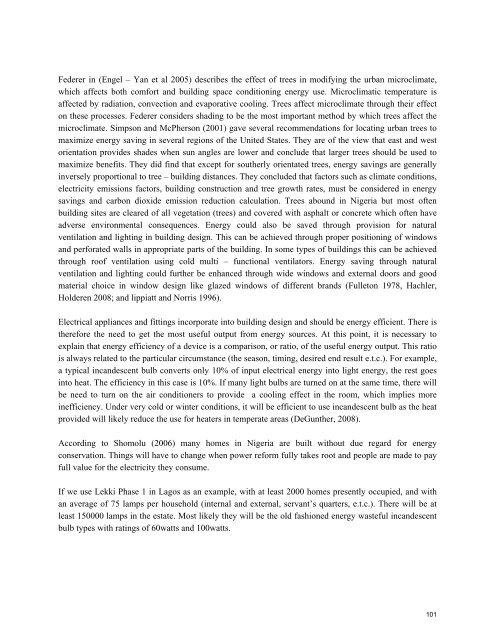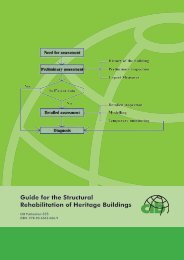CIB W116âSmart and Sustainable Built Environments - Test Input
CIB W116âSmart and Sustainable Built Environments - Test Input
CIB W116âSmart and Sustainable Built Environments - Test Input
Create successful ePaper yourself
Turn your PDF publications into a flip-book with our unique Google optimized e-Paper software.
Federer in (Engel – Yan et al 2005) describes the effect of trees in modifying the urban microclimate,<br />
which affects both comfort <strong>and</strong> building space conditioning energy use. Microclimatic temperature is<br />
affected by radiation, convection <strong>and</strong> evaporative cooling. Trees affect microclimate through their effect<br />
on these processes. Federer considers shading to be the most important method by which trees affect the<br />
microclimate. Simpson <strong>and</strong> McPherson (2001) gave several recommendations for locating urban trees to<br />
maximize energy saving in several regions of the United States. They are of the view that east <strong>and</strong> west<br />
orientation provides shades when sun angles are lower <strong>and</strong> conclude that larger trees should be used to<br />
maximize benefits. They did find that except for southerly orientated trees, energy savings are generally<br />
inversely proportional to tree – building distances. They concluded that factors such as climate conditions,<br />
electricity emissions factors, building construction <strong>and</strong> tree growth rates, must be considered in energy<br />
savings <strong>and</strong> carbon dioxide emission reduction calculation. Trees abound in Nigeria but most often<br />
building sites are cleared of all vegetation (trees) <strong>and</strong> covered with asphalt or concrete which often have<br />
adverse environmental consequences. Energy could also be saved through provision for natural<br />
ventilation <strong>and</strong> lighting in building design. This can be achieved through proper positioning of windows<br />
<strong>and</strong> perforated walls in appropriate parts of the building. In some types of buildings this can be achieved<br />
through roof ventilation using cold multi – functional ventilators. Energy saving through natural<br />
ventilation <strong>and</strong> lighting could further be enhanced through wide windows <strong>and</strong> external doors <strong>and</strong> good<br />
material choice in window design like glazed windows of different br<strong>and</strong>s (Fulleton 1978, Hachler,<br />
Holderen 2008; <strong>and</strong> lippiatt <strong>and</strong> Norris 1996).<br />
Electrical appliances <strong>and</strong> fittings incorporate into building design <strong>and</strong> should be energy efficient. There is<br />
therefore the need to get the most useful output from energy sources. At this point, it is necessary to<br />
explain that energy efficiency of a device is a comparison, or ratio, of the useful energy output. This ratio<br />
is always related to the particular circumstance (the season, timing, desired end result e.t.c.). For example,<br />
a typical inc<strong>and</strong>escent bulb converts only 10% of input electrical energy into light energy, the rest goes<br />
into heat. The efficiency in this case is 10%. If many light bulbs are turned on at the same time, there will<br />
be need to turn on the air conditioners to provide a cooling effect in the room, which implies more<br />
inefficiency. Under very cold or winter conditions, it will be efficient to use inc<strong>and</strong>escent bulb as the heat<br />
provided will likely reduce the use for heaters in temperate areas (DeGunther, 2008).<br />
According to Shomolu (2006) many homes in Nigeria are built without due regard for energy<br />
conservation. Things will have to change when power reform fully takes root <strong>and</strong> people are made to pay<br />
full value for the electricity they consume.<br />
If we use Lekki Phase 1 in Lagos as an example, with at least 2000 homes presently occupied, <strong>and</strong> with<br />
an average of 75 lamps per household (internal <strong>and</strong> external, servant’s quarters, e.t.c.). There will be at<br />
least 150000 lamps in the estate. Most likely they will be the old fashioned energy wasteful inc<strong>and</strong>escent<br />
bulb types with ratings of 60watts <strong>and</strong> 100watts.<br />
101

















